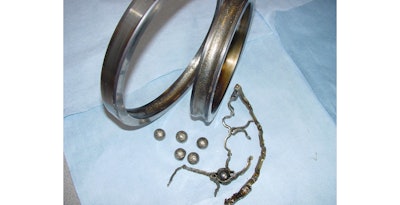
Allied Reliability Group (ARG) specializes in implementing condition monitoring techniques including oil analysis, vibration analysis, infrared thermography, motor circuit analysis and ultrasonic analysis to understand the current state of machinery. Oil analysis detects changes in lubricant chemistry, wear particles that indicate component defects, and contaminants from outside the lubrication system.
This article describes a number of typical examples of how oil analysis can reduce repair costs and improve throughput.
Example 1
A line fills up to 50,000 cans per hour, and then seams the filled cans. The filling machines have an “Automated Clean in Place” program that flushes them with large volumes of water and chemicals. ARG monitors the main oil reservoirs with oil analysis. Over a period of five months, the main drive showed recurring problems with water intruding into the gearbox and oil tanks. The oil was changed frequently and the seals were inspected and replaced but this did not solve the problem. Allied Reliability Group suggested supplying dry air to the oil reservoirs. The overpressure was limited to a small level to avoid blowing out the seals. This approach eliminated the water intrusion problems.
 Oil Analysis shows water intrusion problems in can filling machines.
Oil Analysis shows water intrusion problems in can filling machines.Example 2
The same factory uses a bottle washing machine that rinses bottles before they are filled. Gearboxes drive the translation chain which moves bottles through the machine. Vibration measurements have been successfully used for condition monitoring of the ingoing shaft which operates at 55 rpm. Comparatively, the outgoing shaft operates at only 1 rpm, much too slow for accurate vibration measurements. Therefore, oil analysis is performed every three months on the shaft lubrication reservoir.
A recent measurement using the Spectro 5200 showed a sudden increase of wear particles in the oil. The first step was to change the oil and re-run the oil analysis, but the level of wear particles was also high in the new analysis. The number and size of wear particles continued to increase, revealing particles larger than 40 microns. The machine was shut down and inspected at the first planned stop. The inspection revealed a severely damaged bearing on the outgoing shaft.
The problem was solved by overhauling the reduction gearbox. If the problem had not been detected by oil analysis, the gearbox would have crashed and caused other parts to fail. Production would have been lost because the line could not operate the rinsing machine until the repairs were complete.
 Oil analysis reveals a severely damaged bearing in a bottle washing machine.
Oil analysis reveals a severely damaged bearing in a bottle washing machine.Example 3
A labeling machine in the same factory has the ability to run at 60,000 bottles per hour. The high complexity and structural limitations of this machine means that certain parts can only be monitored by oil analysis. Oil analysis of the gearbox reservoir revealed an increased viscosity, a large increase in the dielectric constant, and a water intrusion.
An inspection of the gearbox showed a large amount of glue intruded into the oil reservoir because a seal failed. If the problem had not been identified by oil analysis, the gearbox would eventually have stopped, resulting in high repair costs and production losses. Accurate oil analysis provided relatively inexpensive corrections that fixed the problem during the next scheduled production stop.
 Oil analysis detects glue in the gearbox reservoir of a labeling machine.
Oil analysis detects glue in the gearbox reservoir of a labeling machine.Example 4
A steel mill uses a cold rolling process in which metal stock passes through one or more pairs of rolls to reduce its thickness and thickness variations. The skin pass is the final cold rolling pass and involves the least amount of thickness reduction, typically 0.5 to 1 percent. The skin pass also produces a smooth, uniform surface on the rolled steel plate. The numerous reducers which drive the skin pass are lubricated from a shared oil reservoir containing 6,000 liters (1,585 gallons) of Shell Omala 220 oil.
 Increased ferrous index in oil analysis - results from skin pass reducers
Increased ferrous index in oil analysis - results from skin pass reducersA recent oil sample showed an increased ferrous index, increased number of particles, and a drop in viscosity from 220 cSt to 82 cSt. Allied Reliability Group advised the steel mill to urgently inspect the oil reservoir. The inspection showed that several heating elements failed which caused the particle count and ferrous index to increase. The inspection also revealed a failure in the circulation pump which caused the oil to overheat and reach high local temperatures. The steel plant replaced the broken heating elements, repaired the circulation pumps, and replaced the oil during a previously planned outage. A new oil sample taken from the same point revealed that the problem was solved. If the company had continued to operate the machine with bad oil the gearboxes would have been damaged, resulting in increased repair expenses and lost production due to an unplanned outage.
The vibrations of faster-moving shafts in the same steel plant are monitored using vibration measurements. But a shaft that drives a gearbox at 9 rpm moves too slow for vibration measurement to be effective. Instead, an oil sample is analyzed every three months.
 Oil analysis detects problems in slow moving shaft
Oil analysis detects problems in slow moving shaftThe most recent oil sample showed an increase in particle count and ferrous particles. Vibration analysis on other shafts driven by the same gearbox did not show any anomalies. The gearbox was opened up and inspected at the next planned stop. The rolling elements of the slow moving axle showed clear signs of grinding. The outer ring of the bearing was black due to the extreme heat generated by the grinding. The bearing would have obviously crashed if it had not been replaced. Oil analysis in this application saved a considerable amount of money in reduced repair costs and by avoiding a production outage.
“These applications are typical of the savings in repair costs and lost production that can be provided by oil analysis,” Maes concluded. “Asset health monitoring finds defects early to prevent unexpected failures and help the organization plan and schedule maintenance. The Spectro 5200 provides clear indications of metal wear, lubricant chemistry and contamination. The instrument also generates machinery health trend analysis to support data driven predictive and preventive maintenance decisions. Lubricant condition monitoring also conserves oil and reduces oil disposal costs by driving maintenance on an as-needed basis.”























